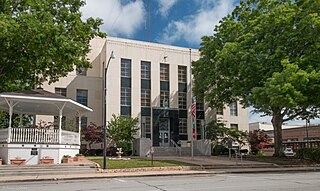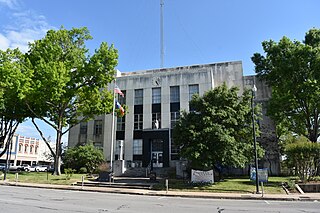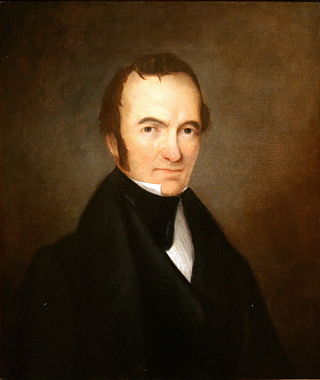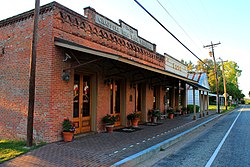
Washington County is a county in Texas. As of the 2020 census, the population was 35,805. Its county seat is Brenham, which is located along U.S. Highway 290, 72 miles northwest of Houston. The county was created in 1835 as a municipality of Mexico and organized as a county in 1837. It is named for George Washington, the first president of the United States.

Hempstead is a city in and the county seat of Waller County, Texas, United States, part of the Houston–The Woodlands–Sugar Land metropolitan area.

Brenham is a city in east-central Texas in Washington County, United States, with a population of 17,369 according to the 2020 U.S. census. It is the county seat of Washington County.

Washington-on-the-Brazos is an unincorporated community along the Brazos River in Washington County, Texas, United States. The town is best known for being the site of the Convention of 1836 and the signing of the Texas Declaration of Independence.

U.S. Route 290 is an east–west U.S. Highway located entirely within the state of Texas. Its western terminus is at Interstate 10 southeast of Segovia, and its eastern terminus is at Interstate 610 in northwest Houston. It is the main highway between Houston and Austin and is a cutoff for travelers wanting to bypass San Antonio on Interstate 10. Throughout its length west of Austin, US 290 cuts across mountainous hills comprising the Texas Hill Country and the Edwards Plateau; between Austin and Houston, the highway then travels through gradually hilly grasslands and pine forests comprising the Gulf Coastal Plains.
Independence is an unincorporated community in Washington County, Texas, United States. According to the Handbook of Texas, the community had a population of 140 in 2000. It is located within the Greater Houston metropolitan area.

Area code 979 is a telephone area code in the North American Numbering Plan (NANP) for the U.S. state of Texas. The numbering plan area comprises the region generally following the Brazos River found between the Austin and Houston metro areas and its surrounding communities, stretching from just south of Waco to the Gulf Coast. It was created on February 13, 2000, in a split from area code 409.

After declaring its independence from Mexico in March, 1836, the Republic of Texas had numerous locations as its seat of government. This being seen as a problem attempts were made to select a permanent site for the capital. January, 1839, with Mirabeau B. Lamar as the newly elected president, a site selection commission of five commissioners was formed. Edward Burleson had surveyed the planned townsite of Waterloo, near the mouth of Shoal Creek on the Colorado River, in 1838; it was incorporated January 1839. By April of that year the site selection commission had selected Waterloo to be the new capital. A bill previously passed by Congress in May, 1838, specified that any site selected as the new capital would be named Austin, after the late Stephen F. Austin; hence Waterloo upon selection as the capital was renamed Austin. The first lots in Austin went on sale August 1839.

The Austin–Round Rock–San Marcos metropolitan statistical area, or Greater Austin, is a five-county metropolitan area in the U.S. state of Texas, as defined by the Office of Management and Budget. The metropolitan area is situated in Central Texas on the western edge of the American South and on the eastern edge of the American Southwest, and borders Greater San Antonio to the south.

Rutersville College, was a coeducational college located in the unincorporated community of Rutersville in Fayette County, Texas, United States. Chartered under the Republic of Texas in 1840, Rutersville College was Texas's first institution of higher education. It was named for Methodist missionary and educator Martin Ruter, who wrote the school's charter and raised funds to establish the institution, which he originally intended to be named Bastrop College. The Congress of Texas initially rejected the school's charter because it affiliated the school with the Methodist Church. Ruter died two years before the school finally opened under a revised charter excluding a religious affiliation.

Central Texas is a region in the U.S. state of Texas surrounding Austin and roughly bordered by San Saba to Bryan and San Marcos to Hillsboro. Central Texas overlaps with and includes part of the Texas Hill Country and corresponds to a physiographic section designation within the Edwards Plateau, in a geographic context.

Soule University was a private Methodist university in Chappell Hill, a rural community in Washington County, Texas, United States. Chartered in 1856 and named after Bishop Joshua Soule, the school replaced the male department of Chappell Hill Male and Female Institute and was intended to succeed the struggling Rutersville College. Soule was beset by financial challenges after the American Civil War and two epidemics of yellow fever, leading the Methodist Church and Soule's president to form Southwestern University as a replacement in 1873. Despite the Texas Legislature transferring Soule's charter to Southwestern in 1875, local supporters kept Soule open until 1887 under the name Soule College.

The Stagecoach Inn of Chappell Hill is a historic stagecoach inn at Main and Chestnut Streets in Chappell Hill, Texas, United States.

Chappell Hill Circulating Library is a historic library on Cedar Street in Chappell Hill, Texas.

Travis County has had two locations named Montopolis. The first was during the Republic of Texas period north of the Colorado River. The second is today's Montopolis neighborhood in Austin, Texas south of the river. Located southeast of the city's urban core, today's neighborhood is in ZIP code 78741. Montopolis is bounded by Lake Lady Bird on the north, by Grove Street and the Pleasant Valley neighborhood on the west, to the south by Texas State Highway 71, and by U.S. Route 183 on the east. The southeast corner abuts Austin-Bergstrom International Airport. Montopolis is in City Council District 3.
The Houston and Texas Central Railway (H&TC) was an 872-mile (1403-km) railway system chartered in Texas in 1848, with construction beginning in 1856. The line eventually stretched from Houston northward to Dallas and Denison, Texas, with branches to Austin and Waco.

The Glenblythe Plantation is a former plantation in Gay Hill, Washington County, Texas. Before the American Civil War, it was cultivated with slave labor. The plantation home is no longer standing, however in 1967, a historical marker was installed where it used to stand, as a reminder of a bygone era.
James Weston Miller (1815-1888) was an American Presbyterian minister, educator and Confederate chaplain in Texas during the American Civil War. He helped establish the First Presbyterian church in Houston and many Baptist and Methodist churches and schools for blacks. He also taught many daughters of the Southern aristocracy at the Live Oak Female Seminary in Gay Hill, Texas.
Chappell Hill Female College was a private college in Chappell Hill, a rural community in Washington County, Texas, United States. It was founded in 1850 as part of the coeducational school Chappell Hill Male and Female Institute. First chartered by the Texas Legislature in 1852 as a non-denominational preparatory school, the charter was amended to affiliate the school with the Methodist Church in 1854, and was rechartered as a women's college after the male department was spun off as Soule University in 1856. It was closed in 1912 and the building became a public school until a replacement was built in 1927 that preserves the college's bell. The site was added to the National Register of Historic Places in 1985.
Longpoint is an unincorporated community in Washington County, Texas, United States. According to the Handbook of Texas, the community had a population of 80 in 2000. It is located within the Greater Houston metropolitan area.

















